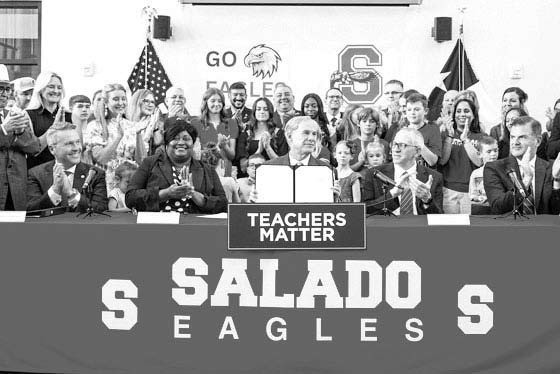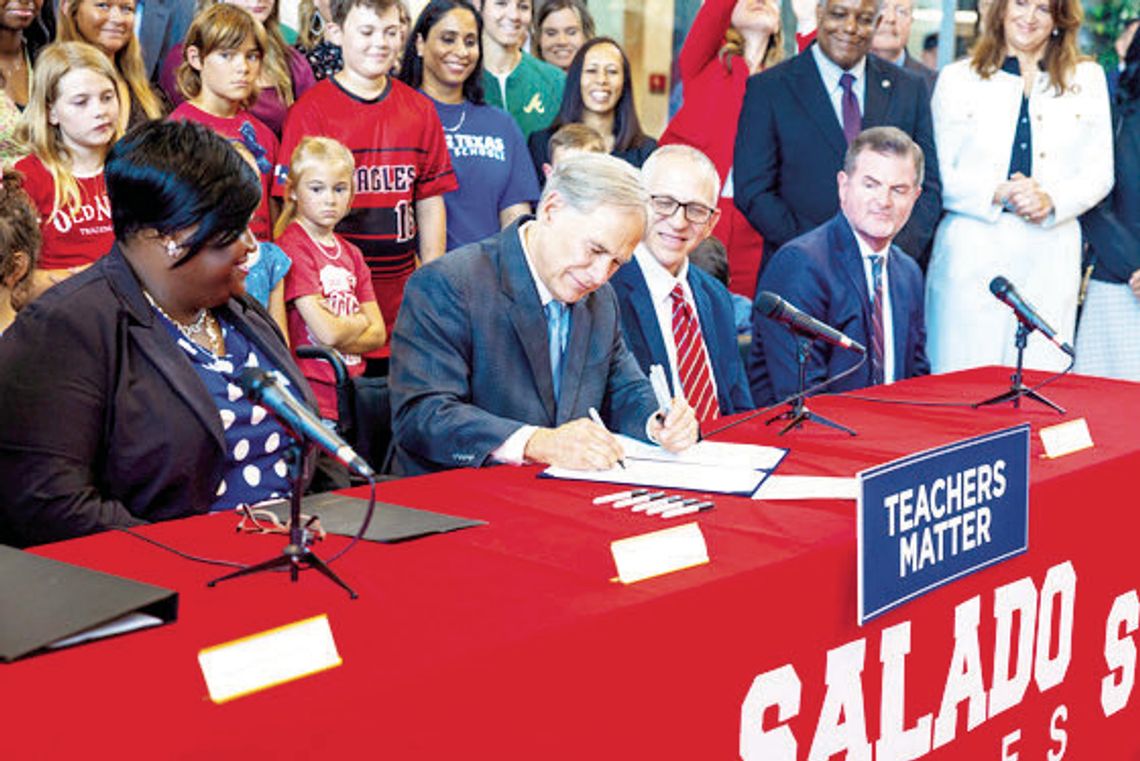SALADO — An $8.5 billion education funding bill signed into law by Gov. Greg Abbott Wednesday is a step in the right direction, according to eastern Williamson County educators.
Abbott signed House Bill 2 June 4 in front of more than 175 educators, students and parents at Salado Middle School. Touted as “historic” legislation, it sets a record $8.5 billion in public school funding, with $4 billion specifically earmarked for teacher and staff pay raises and the state’s merit-based pay program, the Teacher Incentive Allotment.
Although not in attendance at the signing, several local superintendents said the measure will benefit students.
“We appreciate the additional funding HB 2 provides for teacher pay raises,” said Jeni Neatherlin,
“
While this bill does not make us whole financially … we appreciate the additional support.”
— Jeni Neatherlin, Hutto ISD superintendent Hutto Independent School District superintendent. “Investing in our educators is a step in the right direction as they make the greatest difference in the lives of our students … While this bill does not make us whole financially, as we strive to meet the needs of our growing community, we appreciate the additional support.”
Abbott said the funding will catapult Texas to new heights of educational excellence.
“Now is the time to make Texas number one in educating our children,” Abbott said at the ceremony. “House Bill 2 ensures that our schools are funded better than ever, teacher pay and student funding are at all-time highs, reading and math performances will improve and students will be better prepared for the workforce. The foundation is now in place for Texas education to start climbing the ranks.”
In addition to teacher and staff salaries, a breakdown of the funding includes: $1.3 billion for school district operational costs, including insurance, transportation and utilities $834 million for special education reforms $648 million targeted to strategies for improving early literacy and math skills $318 million to provide additional funding to small and rural schools $296 million for adjustments to the Tier II funding formula, which provides a $55 basic allotment increase per student $199 million to expand the charter school facilities allotment $187 million for teacher preparation and certification programs $153 million to expand career and technical education opportunities $30 million to increase the school safety allotment Despite the substantial figures, some area educators expressed cautious optimism— not wholesale support— about the funding, adding they still have questions and concerns about the bill.
“The next several weeks will be critical as districts across the state attempt to receive clarity and guidance on the significant amount of changes that Texas school finance experienced this legislative session,” said Stephen Brosch, Granger Independent School District superintendent. “Several changes made to the original bill will require district finance departments to attempt to predict exactly how some of the worded and added laws will equate to actual funding.”
Brosch noted budget season for school districts is in full swing, and this is already a challenging time of year. Districts also experienced heightened tension as they awaited definitive word on the passage and signing of HB 2.
Taylor Independent School District Superintendent Jennifer Garcia-Edwardsen said HB 2 carries significant implications for next year’s budget, staff pay raises and the future of public schools.
“Our students and educators deserve the stability and support this funding provides,” Garcia-Edwardsen said.
While area superintendents are pleased with the hike in teacher pay, many said the minimal increase in the basic student allotment is disappointing.
The final version of the bill reduced the originally proposed increase from $395 per student to $55.
Allotments are based on average daily attendance, set at $6,160 per student per academic year. That base amount has not changed since 2019.
House Speaker Dustin Burrows, R-Lubbock, said critics should look at the bill in its entirety, not just the reduced allotment.
“Looking at one number and not what the entire bill does, I don’t think is what we need to be doing,” Burrows said in a previous statement.
While Brosch said he’s not happy with some of the Senate’s changes to the original version of HB 2, he said he’s glad the bill passed before the legislative session ended June 2.
“We are grateful that our legislators came to a compromise that increased public education in some ways, but it makes it awfully hard for districts to address the substantial disconnect between inflation and adequate funding in many key areas,” he said.
Lawmakers also approved a $1 billion private-school voucher bill, which Abbott signed in May on the lawn of the Governor’s Mansion. The new law provides students $10,000 annually to be used toward private school tuition, tutoring, textbooks and other education-related expenses.

Gov. Greg Abbott holds up House Bill 2 after he signed it into law Wednesday at Salado Middle School. Photo courtesy Office of the Governor





